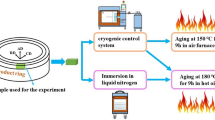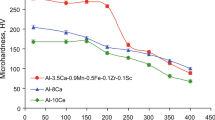The effect of heat treatment involving water quenching, cooling of the quenched alloy in liquid nitrogen, a hold in liquid nitrogen, heating in hot mineral oil (thermal shock), and natural or artificial aging on the structure and properties of deformable aluminum alloy D16 is studied. The structure of the alloy is analyzed by optical and transmission electron microscopy and x-ray diffraction analysis. The effect of the heat treatments on the residual microstresses is determined by the method of drilling holes, and the mechanical properties of D16 are determined in tensile tests.









Similar content being viewed by others
References
T. Croucher, “Minimizing machining distortion in aluminum alloys through successful application of uphill quenching — A process review,” in: L. Canale and M. Narazaki (eds.), Quenching and Cooling, Residual Stresses and Distortion Control, ASTM Int., West Conshohocken, PA (2010), pp. 332 – 351.
Yu. A. Puchkov, Y. Wang, A. Yu. Ampilogov, et al., “A study of the effect of quenching cooling rate on the structure and properties of alloy V91T3 of the Al – Zn – Mg – Cu system,” Tekhnol. Met., No. 8, 15 – 21 (2010).
Yu. A. Puchkov, Y. Wang, V. M. Polyanskii, et al., “A study of decomposition of supercooled solid solution of aluminum alloy V91 of the Al – Zn – Mg – Cu system,” Metalloved. Term. Obrab. Met., No. 8, 16 – 22 (2010).
I. Benarieb, Yu. A. Puchkov, G. G. Klochkov, et al., “A study of the effect of quenching cooling rate on the structure and properties of sheets from high-technology alloy V-1341 of the Al – Mg – Si system,” Materialovedenie, No. 7, 43 – 48 (2019).
Yu. A. Puchkov, V. M. Polyanskii, and L. A. Sedova, “A study of the effect of modes of isothermal quenching on the structure and properties of aluminum alloy V-1341T,” Metalloved. Term. Obrab. Met., No. 2, 13 – 19 (2019).
I. Benarieb, Yu. A. Puchkov, G. G. Klochkov, et al., “Prediction of the effect of quenching mode on mechanical properties of sheets from heat hardenable aluminum alloy V-1341,” in: Role of Fundamental Researches in Implementation of “Strategic Directions of Advancement of Materials and Technologies of their Processing for up to 2030,” Mater. IV All-Russia Conf. [in Russian] (2018), pp. 58 – 70.
E. C. A. Simencio, G. E. Totten, and L. C. F. Canale, “Uphill quenching of aluminum: a process overview,” Int. Heat Treat. Surf. Eng., 5(1), 26 – 30 (2011).
D. A. Lados, D. Apelian, and L. Wang, “Minimization of residual stress in heat-treated Al – Si – Mg cast alloys using uphill quenching: Mechanisms and effects on static and dynamic properties,” Mater. Sci. Eng. A, 527(13 – 14), 3159 – 3165 (2010).
Mai Huan Dung, Yu. A. Puchkov, and S. P. Shcherbakov, “A study of the effect of uphill quenching on residual stresses and properties of aluminum alloy D16,” Zagot. Proizvod. Mashinostr., 18(3), 125 – 129 (2020).
Mai Huan Dung, Yu. A. Puchkov, A. I. Plokhikh, and I. Benarieb, “A study of the effect of heat treatment modes on quenching stresses and properties of steel D16,” Naukoemk. Tekhnol. Mashinostr., No. 4(106), 9 – 17 (2020).
Belinda Gruber, Imgard Weißenstreiner, Thomas Kremmer, et al., “Mechanism of low temperature deformation in aluminum alloys,” Mater. Sci. Eng. A, 795(23), 139935 (2020).
Mai Huan Dung, A. I. Gnevko, and Yu. A. Puchkov, “A study of the effect of cryogenic treatment on residual stresses and properties of aluminum alloy D16,” Aviats. Mater. Tekhnol., No. 2(59), 25 – 31 (2020).
Mai Huan Dung, A. I. Gnevko, et al., “Effect of cryogenic treatment and thermal shock on quenching stresses and properties of alloy D16,” Tekh. Tekhnol., No. 4(13), 473 – 486 (2020).
Mai Huan Dung, Y. A. Puchkov, and S. L. Berezina, “Influence of uphill quenching on residual stresses and properties of alloy D16,” Mater. Today, Proc., 38(4), 1294 – 1298 (2021).
Hak-Jin Lim, Dae-HoonKo, Dae-CheolKo, and Byung-Min Kim, “Reduction of residual stress and improvement of dimensional accuracy by uphill quenching for al6061 tube,” Metall. Mater. Trans. B, 45(2), April, 472 – 481 (2014).
S. C. Wang and M. J. Starink, “Two types of S phase precipitates in Al – Cu – Mg alloys,” Acta Mater., 55, 933 – 941 (2007).
J. R. Davis, ASM Specialty Handbook. Aluminum and Aluminum Alloys, ASM Int. (1993), 784 p.
GOST 21488–97. Bars Pressed from Aluminum and Aluminum Alloys [in Russian].
Author information
Authors and Affiliations
Corresponding author
Additional information
Translated from Metallovedenie i Termicheskaya Obrabotka Metallov, No. 12, pp. 43 – 51, December, 2022.
Rights and permissions
Springer Nature or its licensor (e.g. a society or other partner) holds exclusive rights to this article under a publishing agreement with the author(s) or other rightsholder(s); author self-archiving of the accepted manuscript version of this article is solely governed by the terms of such publishing agreement and applicable law.
About this article
Cite this article
Puchkov, Y.A., Dung, M.X., Plokhikh, A.I. et al. Effect of Cryogenic Treatment and Thermal Shock on Residual Stresses, Structure and Properties of Alloy D16. Met Sci Heat Treat 64, 720–728 (2023). https://doi.org/10.1007/s11041-023-00878-2
Received:
Published:
Issue Date:
DOI: https://doi.org/10.1007/s11041-023-00878-2




